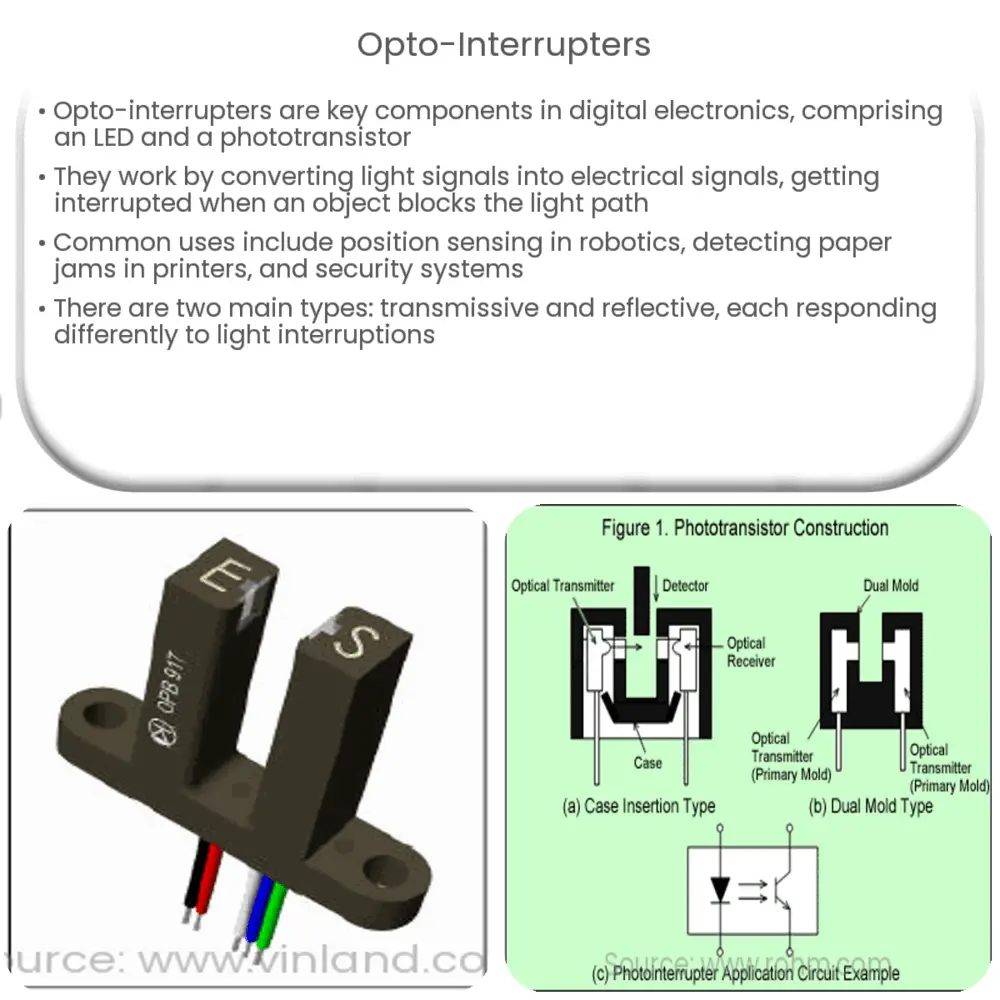Explore the principles, applications, specifications, advantages, and limitations of opto-interrupters in digital electronics.

Introduction to Opto-Interrupters
Opto-interrupters, also known as optical interrupters, photointerrupters, or optocouplers, are indispensable components in a wide array of digital electronics and electromechanical systems. They consist of a light-emitting diode (LED) and a phototransistor, which are optically coupled but electrically isolated from each other.
Working Principle
The working principle of an opto-interrupter is based on the conversion of light signals into electrical signals. The LED inside the opto-interrupter emits light when a voltage is applied. This light is then picked up by the phototransistor, which translates it into an electrical signal. The interesting part is, when something obstructs the light beam between the LED and the phototransistor, the output signal is interrupted. This interruption is then used to trigger other components or circuits within the system.
Applications
-
One of the most common uses of opto-interrupters is in rotary encoders used in motors and robotics for position sensing. The rotating disc interrupts the light beam, enabling the system to determine its position accurately.
-
Opto-interrupters are also frequently used in office equipment like printers and copiers to detect paper jams or to control the movement of paper through the machine.
-
In safety and security systems, opto-interrupters are used to detect unauthorized access. An invisible light beam, when interrupted, triggers an alarm or a security protocol.
Types of Opto-Interrupters
-
Transmissive type opto-interrupters have the LED and phototransistor facing each other. An object passing between them interrupts the light beam, thus triggering a response.
-
Reflective type opto-interrupters work on a similar principle, but the LED and phototransistor are side by side. The light from the LED reflects off an object back to the phototransistor, thus creating a signal.
Opto-interrupters are indeed a staple in many areas of technology. Their ability to provide electrical isolation, coupled with their sensitivity to light, makes them an efficient and reliable solution in various applications. In the following section, we will delve deeper into the intricacies of these devices, exploring their specifications, advantages, and limitations.
Key Specifications
When choosing an opto-interrupter for a particular application, several key specifications must be considered:
-
Operating voltage: This refers to the voltage required to operate the LED within the opto-interrupter.
-
Current transfer ratio: This is the ratio of the output current from the phototransistor to the input current to the LED. Higher ratios mean better sensitivity.
-
Response time: This is the time taken by the phototransistor to respond to the changes in the light from the LED. Faster response times are desirable in applications requiring quick reactions.
Advantages
-
Opto-interrupters offer electrical isolation. As the LED and the phototransistor are optically coupled and not electrically connected, they prevent electrical interference between the input and output sides.
-
These devices are highly sensitive to changes in light, thus providing high precision in their applications.
-
Opto-interrupters are robust and durable, capable of withstanding harsh environments.
Limitations
Despite their many advantages, opto-interrupters do have a few limitations. They can be affected by ambient light, which can cause interference with the light from the LED. This can be mitigated by using a modulated light source or by housing the device in a light-tight enclosure. Additionally, opto-interrupters can be slower than other types of sensors, which might limit their use in high-speed applications.
Conclusion
In conclusion, opto-interrupters are an invaluable tool in modern electronics, offering reliable and accurate sensing capabilities in a variety of applications. Their ability to provide electrical isolation combined with their sensitivity to changes in light makes them a preferred choice in many scenarios. Although they have a few limitations, their benefits far outweigh the drawbacks, making them a staple in the world of digital electronics and electromechanical systems.
As technology continues to advance, it’s anticipated that the functionality and efficiency of opto-interrupters will only improve, expanding their potential use cases and solidifying their role in the future of electronics.

